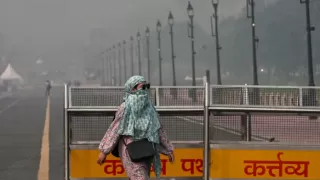The Hayli Gubbi volcano, located in the Afar region of Ethiopia, erupted on Sunday morning, marking its first eruption in nearly 12,000 years. The eruption sent massive plumes of smoke soaring up to 14 kilometres into the sky, a spectacular yet alarming sight witnessed by local residents and captured on social media. Winds carrying volcanic ash at speeds of 100-120 km/h transported the ash across borders, reaching multiple countries, including India. Delhi, already struggling with toxic air, reported the presence of volcanic ash late last night, raising concerns about air quality and flight safety.
The eruption has drawn international attention, not only due to its rarity but also because of its immediate impact on aviation and local populations. The ash plumes first entered Gujarat before drifting towards Rajasthan, Delhi, Haryana, and Punjab. The India Meteorological Department (IMD) confirmed that high-level winds carried the ash across the Red Sea to Yemen and Oman and further over the Arabian Sea towards western and northern India. Despite the ash drift, the IMD stated that the clouds are expected to move away from Indian skies by 7:30 pm, offering temporary relief to affected regions.
Authorities and aviation bodies quickly responded to mitigate risks. The Directorate General of Civil Aviation (DGCA) issued advisories to airlines to avoid volcanic ash-affected areas, adjust flight plans, and report any ash encounters, including engine anomalies or cabin smoke. Airlines such as Air India, IndiGo, and SpiceJet implemented precautionary measures, resulting in several flight cancellations. Safety remained the top priority as crews conducted thorough checks on aircraft that had flown through potentially ash-affected zones.
Impact on Aviation and Safety Measures
The eruption of the Hayli Gubbi volcano posed immediate challenges for international and domestic aviation. Flights from major hubs like Delhi, Mumbai, Hyderabad, Chennai, and Dubai were disrupted due to precautionary measures taken by airlines to ensure passenger safety. Air India canceled eleven flights and conducted thorough checks on aircraft, while IndiGo reassured passengers that all necessary precautions were in place to maintain safe operations.
The DGCA emphasized the importance of monitoring aircraft performance, reporting any suspected ash encounters, and coordinating closely with international aviation bodies. Pilots were advised to avoid specific flight levels and regions affected by volcanic ash. These measures highlighted the critical role of proactive safety protocols in preventing aviation disasters during natural events such as volcanic eruptions.
Environmental Effects and Air Quality Concerns
The eruption of the Hayli Gubbi volcano also raised environmental concerns. While the ash plume mainly contains sulphur dioxide and volcanic ash, experts indicated that it would not significantly affect air quality index (AQI) levels in India. However, regions in the Himalayas, including parts of Nepal and Uttar Pradesh, may experience elevated SO2 levels as volcanic materials interact with mountainous terrain.
Local populations in the Afar region reported seeing thick ash clouds and experiencing strong shock waves reminiscent of explosions. Villages near the volcano were covered in ash, disrupting daily life and agriculture. The eruption serves as a reminder of the geological volatility of the Rift Valley, a zone where tectonic plates converge, making it prone to earthquakes and volcanic activity.
Geological Significance of Hayli Gubbi
Hayli Gubbi is a 500-metre-high volcano situated within the Ethiopian Rift Valley, an area known for its intense geological activity. According to the Smithsonian Institution's Global Volcanism Program, the volcano has not erupted during the Holocene epoch, which began approximately 12,000 years ago. This makes the recent eruption a rare geological event, offering scientists an important opportunity to study long-dormant volcanic systems and the tectonic dynamics of the region.
The eruption highlights the potential hazards associated with dormant volcanoes. While it is unusual for a volcano to remain inactive for millennia, when it does erupt, the impact can be sudden and severe. The Hayli Gubbi eruption demonstrates the need for continuous monitoring of volcanic activity in regions prone to geological instability.
Global Implications and International Response
The ash clouds from Hayli Gubbi extended far beyond Ethiopia, demonstrating the transboundary nature of volcanic eruptions. Winds carried the ash to multiple countries, including India, affecting aviation, air quality, and local populations. Meteorological departments and aviation authorities worldwide are closely monitoring the situation to provide timely advisories and minimize disruption.
International experts noted that the eruption could offer valuable data on volcanic plume behavior, atmospheric transport, and the potential impacts of sulphur dioxide emissions. The event underscores the importance of global collaboration in managing natural disasters, particularly those with far-reaching environmental and logistical consequences.
Preparedness and Lessons Learned
The response to the Hayli Gubbi eruption underscores the significance of preparedness for rare yet high-impact natural events. Airlines, meteorological agencies, and government bodies acted promptly to ensure safety, minimize disruptions, and provide accurate information to the public. Continuous monitoring of volcanoes, public awareness campaigns, and international cooperation are essential to managing similar events in the future.
As the volcanic ash drifts away and affected areas recover, authorities will evaluate the incident to enhance early warning systems, refine aviation protocols, and improve disaster management strategies. The Hayli Gubbi eruption serves as a reminder that even dormant natural phenomena can have sudden and significant consequences, emphasizing the need for vigilance and proactive planning.
Conclusion
The eruption of the Hayli Gubbi volcano in Ethiopia after 12,000 years has drawn global attention due to its rare occurrence, environmental impact, and disruption of aviation and daily life. From thick ash plumes reaching Delhi to precautionary flight cancellations and air quality concerns, the event highlights the far-reaching consequences of natural disasters. It also underscores the importance of preparedness, international cooperation, and continuous monitoring of geological hotspots.
As scientists continue to study Hayli Gubbi and monitor ongoing activity, the eruption serves as both a reminder of nature's power and an opportunity to learn more about volcanic systems dormant for millennia. With coordinated efforts, authorities can ensure public safety, minimize disruptions, and prepare more effectively for future geological events.
Also Read: Peshawar Blast CCTV Shows Shocking Explosion Outside HQ


























